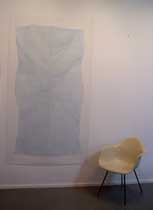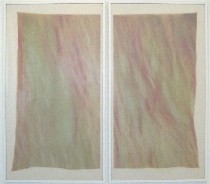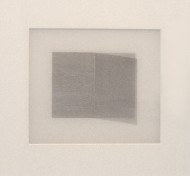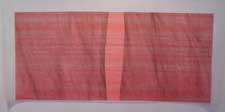Post by Douglas Witmer

[Ed note: This is the beginning of an email Q&A between artblog contributor Douglas Witmer and artist Linn Meyers. It was sparked when the two artists met at Meyers’ opening at Gallery Joe for her current exhibition which closes July 2. Meyers creates reductive drawings using systems and layers of color and line on both sides of sheets of mylar. In addition to showing at Gallery Joe, Meyers exhibits at Margaret Thatcher Projects in New York. See her website for more pictures and information. More parts of the conversation will follow. ]
DW How did you arrive at the direction of the work you make?
LM Up to my third year in college there were only a couple of pieces that I did that really mattered to me. I still have one, it’s a painting of the sheet that divided my junior year studio from the other students’ — painted in chiaroscuro on a found piece of wood. Very renaissance, which isn’t surprising, since I taught myself how to draw by copying pictures of old masters’ drawings. (in the studio is “Untitled 2004,” ink on mylar.)
When I was in my final year at Cooper Union in 1989-90, I was doing some magical realism — mostly involving landscapes. I remember thinking that the images should make the viewer feel out of balance — the idea being that if one feels physically out of balance it will sort of wake you up to your internal world. Of course, most of those paintings were only moderately successful.
Dropping the horizon line

When I moved out to Oakland, CA in ’91, the landscape paintings I was doing ended up being read as relating to “The Environment.” At the time it seemed that everything was being understood in terms of one’s political issues. My mentor, Dennis Leon, suggested I examine why I was using the landscape genre at all in the paintings, and that question lead me to eventually drop the horizon, which had become an artificial device. The resulting paintings, which lacked an identifiable perspective without the horizon line, became more abstract. But of course, I was still thinking of them as landscapes! (image is “200448” from the Gallery Joe exhibit.)
When I got back to New York in 1994 I began to let go of the few remaining references to nature that still existed in the compositions. The paintings became more about mark-making at that point, which was a big breakthrough.
Doing away with illusion
At that point, I was also interested in doing away with illusion, which had come to seem like another insincere device. Unfortunately, when I finally got to the point where I was making paintings that had no illusion of space or light, images that were mostly just repetitive marks, I found that I didn’t like them! I sort of hit a road block at that point, and I floundered around for a while, making things that now seem rather decorative.
Slow breathing in Omaha

Eventually, while I was on a residency at The Bemis Center in Omaha, NE, my work made a leap. I was given this huge beautiful studio in which to work without any interruption. It was winter in Omaha. And I was lost. Somehow, I ended up doing these system-based pencil drawings that lead me onto my current path. I drew small, individual squares; each square was connected at its corners to other squares. They looked like fishing nets rather than grids. As I inhaled, I drew a small square, and then as I exhaled I drew another. I tried to slow myself down. I guess it was a response to being in solitary confinement in Omaha. Rather than breathing faster to try to speed up the whole thing, I slowed everything down and became incredibly focused. It was amazing. Since that point, most of my drawings have had some sort of system behind them. And they have mostly had something to do with time. (image is “200458bc” from the Gallery Joe exhibit)
DW I’m particularly interested in what has lead you to focus on drawing.
LM I think it’s the immediacy and directness of the medium. There’s never a moment when I am forced to turn away from the picture I am making, (to mix paint, clean a brush, etc.) A pen feels like a direct extension of my body, so there is less of a partition between my work and me. I also just love the feeling of putting a rigid point (the point of a pen) against the hard surface of the Mylar on the wall. There’s a lovely resistance between the two materials. “Resistance”–that’s also something that I love. And its absence.

This all sort of loops back to those ideas I had in the late 90’s. I’ve found that for me the way to really wake myself up (and hopefully the way to wake up the viewer as well) is to be deeply focused while I am working. Rather than looking to make an image that is out of balance, (as I did back in the late 80’s and early 90’s,) I am seeking balance. Or examining the way it comes and goes. Appreciating the temporary loss of balance at times. (image is “Untitled” from Meyers’ last Margaret Thatcher Projects show.)
–Artist Douglas Witmer is an artblog contributor and fellow blogger. Check out his blog dgls.









